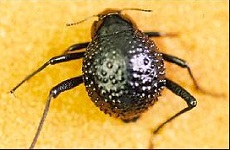
As I reported recently, ten towns in northern NSW and the Southern Downs in Qld are at high risk of running out of water. Indeed news.com reports that Stanthorpe could be dry by Christmas, with nearby Warwick at risk of running out in 17 months’ time.
Nature worked out how to extract water from desert air with the evolution of the Namibian fog beetle (above). The image is from my files, so I’ve posted about it before, I reckon about 10 years ago. I googled and found this article:
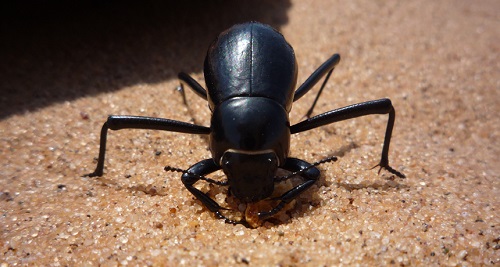
Along the southwestern coast of Africa in the Namib Desert where rainfall can be as little as 10 millimeters each year, four beetles have learned to get a drink from the fog that tends to roll in from the sea:
- When the fog rolls in, the beetle stands atop the dunes on tiptoe. It then sticks its rear end up into the humid morning air. Fog droplets strike and then cling to the beetle’s back. Or humidity can condense into water right on the insect’s shell. When the drops there grow large enough, they roll off the beetle’s back and down to its mouth for a refreshing drink.
A large part of the trick is in the shapes of the tiny bumps on the shells, which have flatish tops with rounded edges. Scientists have actually tweaked the shape to maximise the water extraction.
Recently New Scientist ran an article by Nic Fleming How to suck water from desert air and quench the planet’s thirst. It has another story from the Cuchumatanes mountains of Guatemala where nets up to about twice the size of a car parking space supply villagers with up to 200 litres of freshwater a day:
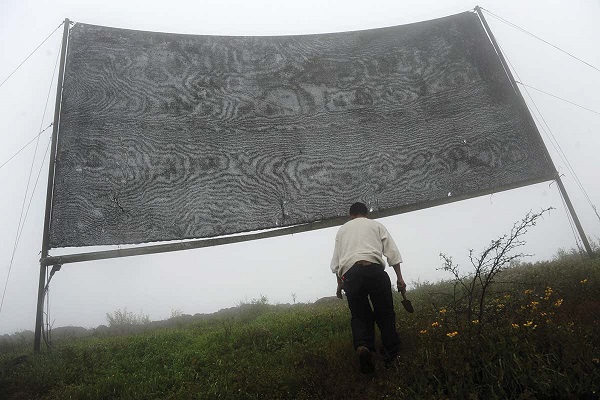
The article has yet another story, that of Omar Yaghi, who started life as a Palestinian refugee in a refugee camp in Jordan, where in a family of 10 you had to think of every drop of water you used. Eventually he came to be working at the University of California, Berkley, on complex synthetic materials known as metal organic frameworks (MOFs). There he came up with MOF-5, a zinc-based polymer which was stable to an impressive 300˚C. Incredibly the gaps in this material gave it an internal surface area of 2900 square metres – nearly half a soccer pitch – per gram. That was in 1999.
MOFs have a variety of industrial applications. Later in 2013 when working on another project Yaghi noticed an MOF that was especially good at absorbing water. He surveyed the field and came up with a system that looked like this:
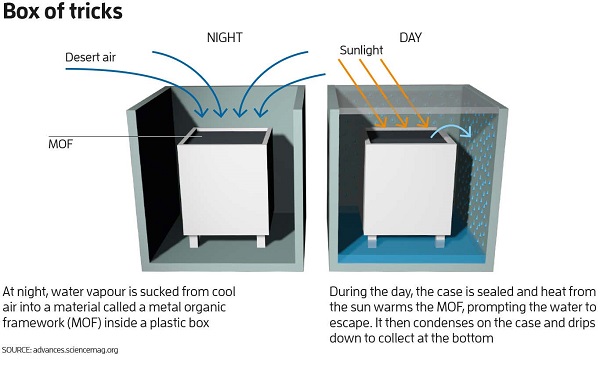
To speed up the process a cold surface will cool the air around it and force water vapour to form droplets, but it is power-hungry.
Things have progressed from there:
- Yaghi, who recently set up a company called Water Harvesting Inc., knows he needs to think about economics as well as chemistry if his plans for a household appliance to help those at threat of water scarcity are to come to fruition. To that end, he has been testing MOF-303, which is based on aluminium, a much cheaper metal. In 2018, he reported devices based on this material could produce 230 millilitres of water per kilogram. He says he can boost that to more than 2 litres if he connects solar panels to the device and uses them to successively heat and cool it many times in 24 hours, rather than relying on day-night temperature cycles.
There are others in the field:
- Zero Mass Water, a company based in Arizona, promises to do this using large, solar-powered condensers it calls hydropanels. Two can draw around 10 litres of water per day from the air, even in arid climates, it says.
The problem the company faces is the energy required. It takes about 1.4 megajoules to produce a litre of water, roughly the same amount of energy required to boil the water for 40 cups of tea. On the other hand, the tech does away with the need for infrastructure to send water from place to place, which requires energy to install. This system is also readily scalable – to get more water, just add more panels.
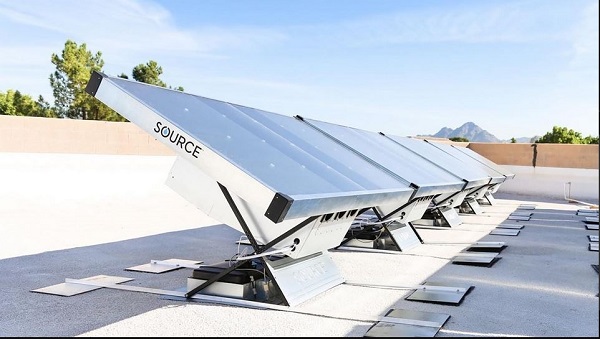
And:
- Late last year, a company called Skywell launched the UK’s first office water cooler that condenses water directly from the air. In future, the firm plans to sell an industrial unit big enough to serve a small town.
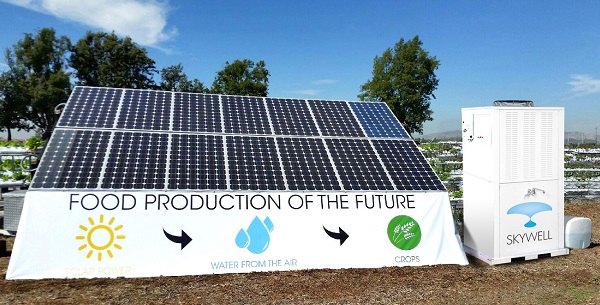
Their target market ranges from office water coolers to small town supply, to food production.
I don’t know about the economics, but I do believe that electricity in the post fossil fuel era will be plentiful and cheap.
A Saudi wind project has announced what it says is a world record-low onshore wind levellised cost of electricity (LCOE) of 1.99 US cents per kilowatt-hour (kWh).
Australian utility Alinta Energy is ramping up its push into renewables, citing stunning low costs that will enable dispatchable wind and solar to compete with existing fossil fuel plant.
Apparently these ‘water from air’ technologies only need 20 per cent humidity as a a threshold for viability.
The NS article says the United Nations estimates the number of people living in areas of absolute water scarcity, where available supplies are insufficient to meet demand, will rise from 1.2 billion in 2014 to 1.8 billion in 2025.
Hence the potential is large. Perhaps some Australian towns would do well to investigate the potential, especially for vital services, such as hospitals.
Update: Here’s a YouTube on the Berkely MOF (metal organic frameworks) research from 2019.

Brian:
Humidity for Newman is currently 18%, dew point less than zero. It is pretty dry out there.
John, I clicked on your link, and it showed “relative humidity” at 39%. and between 31% and 43% over the last couple of days. Am I looking in the wrong place?
Interesting.
I looked up Namib desert and learnt that both the Namib and Atacama deserts are classified as “fog deserts”.
It seems rainfall isn’t the only measure of available water.
Looks like Newman’s relative humidity varies quite a bit.
Of course it could be the Bureau of Meteorology fudging the figures to stimulate ambivalence among the people who are definitely not denying climate change.
Brian: The figure seemed to be moving but I must admit that I didn’t go into the details that wold tell how practical the proposed water recovery system would be. Far more likely to work in a place like Stanthorpe.
Zoot: Newman is in the middle of WA and opposite Rocky. Always be a place that can get very hot and very dry. When we lived there we used to describe a summer day that didn’t go above 40 deg C as a “cool summers day.” When the temperature got above about 43 deg C it was cooler out of the breeze. Probably not an ideal place to be trying to recover water from the air. Fortunately the place had an aquifer recharge system that ensured the water supply was adequate enough to keep the lawns green.
John, I’ve been to Newman – in the seventies, backing (if memory serves) acts like Kamahl and Harry Secombe. I can’t imagine a less likely place to extract water from the air (except maybe Sandstone). 🙂
I saw a few articles along the way, and I think the 20% threshold only appeared once, so I really don’t know how important it is. I put it in because with present technologies there does seem to be a limit. Obviously the amount of humidity is a significant factor.
In an aside at a meeting I attended, I think someone from the Southern Downs mentioned that a hospital was looking at closing because of a lack of water. I imagine, but don’t know, that around the Granite Belt where Stanthorpe is there is no bore water. I would think these new water from air technologies would be worth investigating.
zoot
You met Harry Secombe?
Did he reminisce about The Goons, or was that more a hobby of Spike Milligan?
Cheerio
Ambi, yes he did have stories of the Goons, but I don’t remember him being a particularly reminiscing type. He was very much in the present and exceedingly funny. Always with the caveat that my memory is pretty patchy (sex and drugs and rock ‘n roll and all that) 🙂
Exceedingly funny – good to hear it. So it wasn’t only Sellers and Milligan who created the comedy….
Thanks.
Oh, and also, many of us old geezers have poor memories, though as far as we can recall, there wasn’t much in the way of drugs or rock and roll in our old days. You musicians, legendary performers
Premier Palaszczuk visited Stanthorpe today.
I gather they are going to truck water to Stanthorpe.
Brisbane water by the tanker load is not horrendously expensive. Upper Brookfield, a Brisbane suburb where I’ve worked for years has no town water supply. When tanks have run dry, people have been known to buy Brisbane water.
Seems to me the water from air might be appropriate in remote places without water supply infrastructure.
Brian: Aquifer recharge can make a lot more sense than storing water in dams, particularly relatively shallow dams/evaporation ponds. Newman (pop 6000) started using underground water found in the rubble filling the river bed sitting on top of imperious banded iron. When we went there they had just built a recharge dam that collected water when the rain condescended to fall and then ran this water down slowly to recharge trenches dug in the rubble in the shallow areas of the river bed. May make sense in granite country with high evaporation rates.
It doesn’t seem that precipitation has decreased due to global warming..
https://www.epa.gov/sites/production/files/styles/large/public/2016-07/precipitation-download2-2016.png
Perhaps more capture and storage infrastructure resistance is unwise.
Who told you it would?
Most climate change experts have pointed out that precipitation in many areas will increase.
Makes sense when you consider that as the temperature rises the atmosphere can carry more water vapour which would lead to more precipitation.
Those same experts warn that the distribution will not be even, which is why SW WA is getting less rainfall these days.
Really ?
I’m not convinced of that.
Perhaps you have graphs of annual precipitation for SA and WA that show that to prove it, let’s see them.
Sorry not SA and WA, but SW WA.
I misread but the challenge remains.
You’ve broken your Google again?
Try this
Hi Brian, if going electric means going substantially solar in an optionally off grid way and for $25,000, I think that you will find that anyone currently buying electricity can afford to do that if they own their property. The base interest only finance maintenance cost at todays mortgage rates for $25,000 is just $875 per year. Of course the principle must be paid down which would be an additional $2500 per year over ten years giving a weekly cost of around $65 per week. If one was paying $2000 a year for electricity then that weekly cost minus the saving becomes $26.5 per week. Of course if one is paying less than the $2000 per year for electricity then they likely don’t need the $25,000 package and every thing compensates downwards.
When it comes to water from thin air I think that desalination from sea water is a better option as that costs, energy wise, 2 watt hours of electricity per litre. Much more efficient. Of course not everyone has sea water on tap, so there may be a more efficient in a reversed version of his system https://youtu.be/R_g4nT4a28U .
Efficiency wise my wife and I living on our boat are using around 400 litres water per week having a shower each every day and doing all of the other normal things including watering our herb garden. When we are running a desalinator that will cost at 3 times the most efficient systems 2400 watt hours of electricity per week to extract the 400 litres. So with 3 high efficiency panels giving peak 750 watts per hour, even derated to 25% we can make water and run our lives electrically easily on solar alone.
BilB, and Jumpy, I’ve got no access to the engineering skills required, and I doubt that anyone could successfully convert a 2006 Falcon ute where the body is essentially a variation of the Falcon sedan.
It happens to be the body type that suits me for how I use the ute. I have to take into account my ability to lift a 33kg mower on and off the back and some other considerations I won’t bore you with.
Bottom line also is that realistically I’m probably near the end of my part-time working life in that sphere. Each summer I need to assess whether I can hack it working in the heat. Some time in the next five years, the answer will likely be “no”.
That is not the full extent of my particular circumstances, which is why, Jumpy, I don’t appreciate other people making judgements about what it is appropriate for me to do.
And don’t say you were just trying to help. You said it was a factor in who you would trust.
Zoot, I’m amazed that Jumpy would not understand that rainfall and in particular stream flow have been in trend decline in the SW corner of WA. My understanding is that Perth is using desalination and underground aquifer storage as ongoing features of their water infrastructure.
When we crossed the Simpson Desert, we lost a lot of our water in the first few hours, so were probably on about 2 litres per person per day.
This meant going four days without a shower. I have itchy skin in places, and my skin was never better.
It was early August, so not hot weather.
Brian, my memory’s not perfect but I’m sure I’ve had this exchange with our Mackay correspondent previously on more than one occasion. I’m also sure you’ve mentioned it in at least one of your 232 Climate Clippings.
But Jumpy does appear to automatically take a contrarian position to most posts on this blog. I suspect he believes he’s pwning the libtard snowflakes.
Oh, OK Brian, so the article was about electrifying cars? I couldn’t see which link you were referring to. In that case you are correct. There is no point in electrifying old cars. If the government is not positively engaged and supportive then there is no point in the odd person going electric transport.
I’m in Australia at the moment (finally have my Netherlands residency approved and will be back there in 5 or 6 weeks indefinitely). Transport there is on another level altogether. I’ve lived there for 3 months this year driving some 8000 klms and I have not witnessed a single vehicle accident ie dinged cars on the side of the road from a recent accident or an accident being dealt with. Part of the success of this is that the traffic flows freely at speeds up to 130 kph and their driver courtesy is highly developed. The most important rules in the Netherlands for car drivers is that pedestrians and cyclists are always in the right, even when they are at fault, and there is a very good reason for this. It is routine there for a parent to cycle with two and three children aboard. If you hit and injure a cyclist you could well be injuring a whole family, 4 people. And another reason is everyone rides bicycles in the Netherlands, cyclists are not a fringe group as they are in Australia. It is awesome to see whole families and groups of families out riding around the towns, and that is all carbon free.
Here is a paper on desiccant water extraction.
https://www.researchgate.net/profile/Arvind_Singh56/post/Is_it_possible_to_convert_atmospheric_moisture_into_useful_source_of_drinking_water_economically/attachment/59d6516479197b80779a9eb8/AS%3A507197652439040%401497936751918/download/A+TECHNICAL+REVIEW+ON+THE+EXTRACTION+OF+WATER.pdf
One of my favourite Australian inventions, though, is the Icy Ball.
https://en.m.wikipedia.org/wiki/Icyball
This wonderfully simple concept can be adapted to water extraction and air conditioning both solar and fuelled. That development will not happen until fossil energy becomes more expensive, so we are still limited by the right wing BS.
BilB, we were in Amsterdam in 2008. Here’s a couple of photos my brother took:
Yes Brian, I saved both of those images, they really struck a chord with me. I particularly love the Dad struggling up the incline with proud Mom looking on. This is a very common reality here only the cargo bike configuration is very common today, and with electric power (this is the disaster of Australia’s 240 watt maximum power imagining just one user type) mothers routinely move their family around in this way. I caught a glimpse of a mother going past with a bike trailer and her three children snuggled up inside. I gave a burst of laughter and the Mom turned with a smile. She was quite chuffed with the way she had nested he little tribe. I’ll send you an image of a FedEx cargo bike that I got a brief glimpse of whistling past in Harlem. Quite extreme but eminently serviceable. Do I love the Dutch way of life? Absolutely, and I am particularly enjoying my share of it.